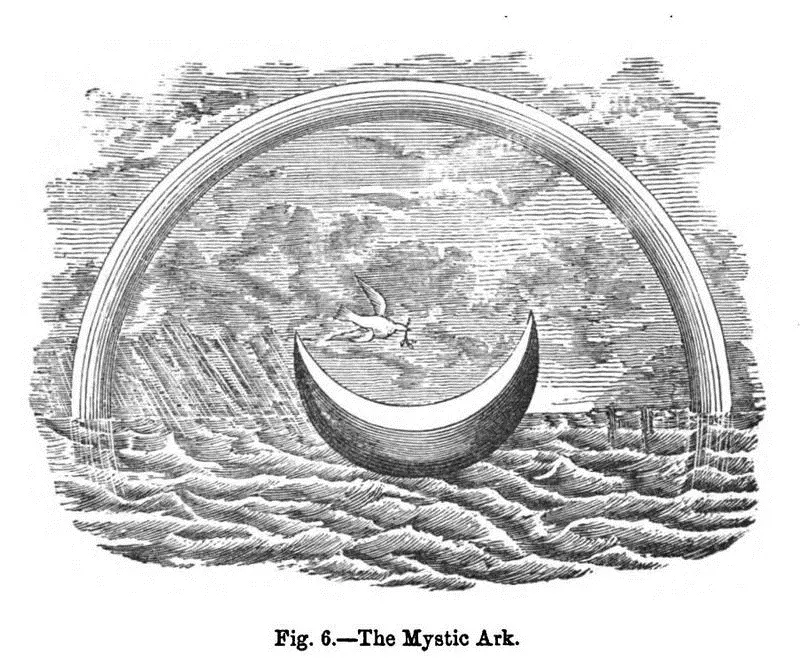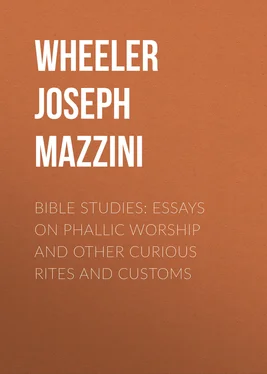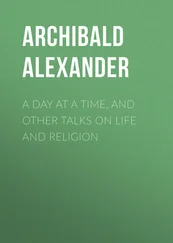Joseph Wheeler - Bible Studies - Essays on Phallic Worship and Other Curious Rites and Customs
Здесь есть возможность читать онлайн «Joseph Wheeler - Bible Studies - Essays on Phallic Worship and Other Curious Rites and Customs» — ознакомительный отрывок электронной книги совершенно бесплатно, а после прочтения отрывка купить полную версию. В некоторых случаях можно слушать аудио, скачать через торрент в формате fb2 и присутствует краткое содержание. Жанр: foreign_prose, foreign_religion, Философия, foreign_psychology, foreign_antique, на английском языке. Описание произведения, (предисловие) а так же отзывы посетителей доступны на портале библиотеки ЛибКат.
- Название:Bible Studies: Essays on Phallic Worship and Other Curious Rites and Customs
- Автор:
- Жанр:
- Год:неизвестен
- ISBN:нет данных
- Рейтинг книги:4 / 5. Голосов: 1
-
Избранное:Добавить в избранное
- Отзывы:
-
Ваша оценка:
- 80
- 1
- 2
- 3
- 4
- 5
Bible Studies: Essays on Phallic Worship and Other Curious Rites and Customs: краткое содержание, описание и аннотация
Предлагаем к чтению аннотацию, описание, краткое содержание или предисловие (зависит от того, что написал сам автор книги «Bible Studies: Essays on Phallic Worship and Other Curious Rites and Customs»). Если вы не нашли необходимую информацию о книге — напишите в комментариях, мы постараемся отыскать её.
Bible Studies: Essays on Phallic Worship and Other Curious Rites and Customs — читать онлайн ознакомительный отрывок
Ниже представлен текст книги, разбитый по страницам. Система сохранения места последней прочитанной страницы, позволяет с удобством читать онлайн бесплатно книгу «Bible Studies: Essays on Phallic Worship and Other Curious Rites and Customs», без необходимости каждый раз заново искать на чём Вы остановились. Поставьте закладку, и сможете в любой момент перейти на страницу, на которой закончили чтение.
Интервал:
Закладка:
In the temple at Jerusalem the women wove hangings for the Asherah (2 Kings xxiii. 7), that is for concealment in the worship of the genetrix, and in the same precincts were the houses of prostitute priests (see also 1 Kings xiv. 24; xv. 12; xxii. 46. Luther translates " Hurer "). Although Josiah destroyed these, B.C. 624, Kalisch says "The image of Ashtarte was probably erected again in the inner court (Jer. xxxii. 34; Ezek. viii. 6)." Ezekiel says (xvi. 16), "And of thy garments thou didst take, and deckedst thy high places with divers colors and playedst the harlot thereupon," and (v. 24) "Thou hast also built unto thee an eminent place, and hast made thee a high place in every street," which is plainly translated in the Roman Catholic Douay version "Thou didst also build thee a common stew and madest thee a brothel house in every street." The "strange woman," against whom the Proverbs warns, practised her profession under cover of religion (see Prov. vii. 14). The "peace offerings" there alluded to were religious sacrifices.
Together with their other functions the Kadeshah, like the eastern nautch girls and bayaderes, devoted themselves to dancing and music (see Isaiah xxiii. 16). Dancing was an important part of ancient religious worship, as may be noticed in the case of King David, who danced before the ark, clad only in a linen ephod, probably a symbolic emblem (see Judges viii. 27), to the scandal of his wife, whom he had purchased by a trophy of two hundred foreskins from the uncircumcised Philistines (1 Sam. xviii. 27; 2 Sam. vi. 14-16). When the Israelites worshipped the golden calf they danced naked (Exodus xxxii. 19, 25). They sat down to eat and to drink, and rose up to play , the word being the same as that used in Gen. xxvi. 8. The word chag is frequently translated "feast," and means "dance." In the wide prevalence of sacred prostitution Sir John Lubbock sees a corroboration of his hypothesis of communal marriage. Mr. Wake, however, refers it to the custom of sexual hospitality, a practice widely spread among all savage races, the rite like that of blood covenanting being associated with ideas of kinship and friendliness.
We have seen that the early Jews shared in the phallic worship of the nations around them. Despite the war against Baal and Asherah worship by the prophets of Jahveh, it was common in the time of the Judges (iii. 7). Solomon himself was a worshipper of Ashtoreth, a faith doubtless after the heart of the sensual sultan (1 Kings xi. 5). The people of Judah "built them high places and phalli and ashera on every high hill and under every green tree. And there were also Sodomites in the land" (1 Kings xiv. 23, 24). The mother of Asa made "an abominable image for an Asherah" (1 Kings xv. 13). 12 12 Larousse, in his Grande Dictionnaire Universelle, says: "Le phallos hébraique fut pedant neuf cent ans le rival souvent victorieux de Jéhovah."
The images of Asherah were kept in the house of Jahveh till the time of Josiah (2 Kings xxiii. 6). Dr. Kuenen says ( Religion of Israel , vol. i., p. 80), "the images, pillars and asheras were not considered by those who worshipped them as antagonistic to the acknowledgment of Jahveh as the God of Israel." The same writer contends that Jeroboam exhibiting the calves or young bulls could truly say "These be thy gods, O Israel." Remembering, too, that every Jew bears in his own body the mark of a special covenant with the Lord, the reader may take up his Bible and find much over which pious preachers and commentators have woven a pretty close veil. I will briefly notice a few particulars.
Without going into the question of the translation of Genesis i. 2, it is evident from v. 27 that God is hermaphrodite. "So God created man in his own image, in the image of God created he him, male and female (zakar and nekaba) created he them."
It is not difficult to find traces of phallicism in the allegory of the Garden of Eden. This has been noticed from the earliest times. The rabbis classed the first chapters of Genesis with the Song of Solomon and certain portions of Ezekiel as not to be read by anyone under thirty. The Manichæans and other early Christians held the phallic view. Clement of Alexandria (Strom iii.) admits the sin of Adam consists in a premature indulgence of the sexual appetite. This view explains why knowledge was prohibited and why the first effect of the fall was the perception of nakedness. Basilides contended that we should reverence the serpent because it induced Eve to share the caresses of Adam, without which the human race would never have existed. Many modern writers, notably Beverland and Dr. Donaldson, have sustained the phallic interpretation. Archbishop Whately is also said to have advocated a similar opinion in an anonymous Latin work published in Germany. Dr. Donaldson, who was renowned as a scholar, makes some curious versions of the Hebrew. His translation of the alleged "Messianic promise" in Genesis iii. 15, his adversary, Dr. Perowne, the present Dean of Peterborough, says, is "so gross that it will not bear rendering into English." A good Hebraist, a Jew by birth, who had never heard of Dr. Donaldson's Jashar , gave me an exactly similar rendering of this verse—which makes it a representation of coition—and instanced the phrase "the serpent was more subtle than the other beasts of the field," as an illustration of early Jewish humor.
The French physician, Parise, eloquently says: "This sublime gift of transmitting life—fatal perogative, which man continually forfeits—at once the mainstay of morality by means of family ties, and the powerful cause of depravity—the energetic spring of life and health—the ceaseless source of disease and infirmity—this faculty involves almost all that man can attain of earthly happiness or misfortune, of earthly pleasure or of pain; and the tree of knowledge, of good and evil, is the symbol of it, as true as it is expressive."
Dr. Adam Clarke was so impressed by the difficulty of the serpent having originally gone erect, that he thinks that nachash means "a creature of the ape or ourang-outang kind." Yet it has been suggested that a key to the word may be found in Ezekiel xvi. 36, where it is translated "filthiness." There is nothing whatever in the story to show that the serpent is the Devil. This was an after idea when the Devil had become the symbol of passion and the instigator of lust. De Gubernatis, in his Zoological Mythology (vol. ii., p. 399), says "The phallical serpent is the cause of the fall of the first man." Many other difficulties in the story become less obscure when it is viewed as a remnant in which a phallic element is embodied.
Some have detected a phallic signification in the story of the ark and the deluge, a legend capable of many interpretations. The phallic view is represented in the symbols in fig. 6, taken from Jacob Bryant's Mythology, vol. iv., p. 286, in which the rainbow overshadows the mystic ark, which carries the life across the restless flood of time, which drowns everything that has life, and promises that seed-time and harvest shall endure, and the Ruach broods over the waters. Gerald Massey devotes a section of his Natural Genesis to the typology of the Ark and the Deluge. M. Clermont-Ganneau holds that the Ruach was the feminine companion of Elohim, and that this idea was continued under the name of Kodesh the Euach Kodesh or Holy Ghost, which with the Jews and early Nazarene Christians was feminine.

Another point to be briefly noticed is Jacob's anointing of the stone which he slept on, and then erected and called Beth El, or "house of God," the residence of the creative spirit. This was a phallic rite. Exactly the same anointing of the linga is performed in India till this day. It is evident that Jacob's worship of the pillar was orthodox at the time the narrative was written, for God sends him back to the pillar to perform his vow (see Gen. xxxv.), and again he goes through phallic rites (v. 14). When Paul says, "Flee fornication. Know ye not that your body is the temple of the Holy Ghost?" he elevates and spiritualises the conception which lay in the word Bethel. According to Philo Byblius, the huge stones common in Syria, as in so many lands, were called Baetylia. Kalisch says it is not extravagant to suppose that the words are identical. From this custom of anointing comes the conception of the Messiah, or Christ the Anointed. Kissing the stone or god appears also to have been a religious rite. Thus we read of kissing Baal (1 Kings xix. 18) and kissing the "calves" (Hos. xiii. 2). Epi-phanius said that the Ophites kissed the serpent which this wretched people called the Eucharist. They concluded the ceremonies by singing a hymn through him to the Supreme Father. (See Fergusson's Tree and Serpent Worship , p. 9.) The kissing of the Mohammedan saint's member and of the Pope's toe are probably connected. Amalarius, who lived in the age of Charlemagne, says that on Friday ( Dies Veneris ) the Pope and cardinals crawl on all fours along the aisles of St. Peter's to a cross before an altar which they salute and kiss.
Читать дальшеИнтервал:
Закладка:
Похожие книги на «Bible Studies: Essays on Phallic Worship and Other Curious Rites and Customs»
Представляем Вашему вниманию похожие книги на «Bible Studies: Essays on Phallic Worship and Other Curious Rites and Customs» списком для выбора. Мы отобрали схожую по названию и смыслу литературу в надежде предоставить читателям больше вариантов отыскать новые, интересные, ещё непрочитанные произведения.
Обсуждение, отзывы о книге «Bible Studies: Essays on Phallic Worship and Other Curious Rites and Customs» и просто собственные мнения читателей. Оставьте ваши комментарии, напишите, что Вы думаете о произведении, его смысле или главных героях. Укажите что конкретно понравилось, а что нет, и почему Вы так считаете.












